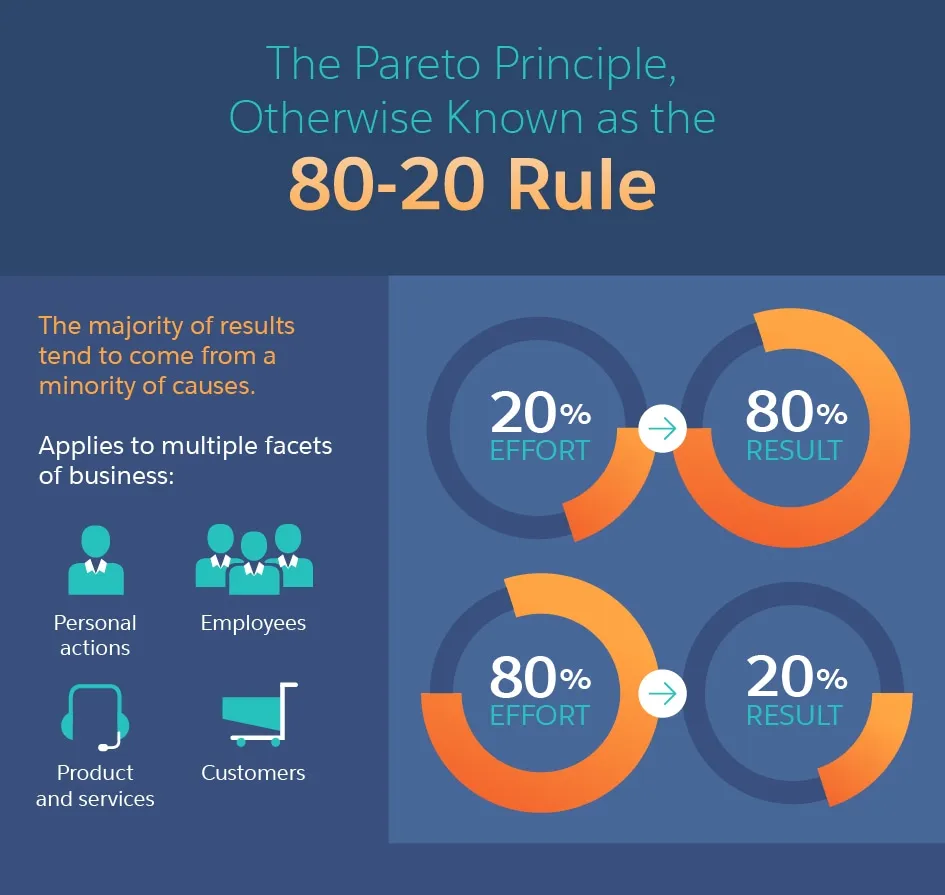In the late 19th century, an Italian economist named Vilfredo Pareto noticed something unusual: Roughly 20 per cent of the peapods in his garden produced nearly 80 per cent of the peas. Not exactly front page news, and yet Pareto’s observation would provide the foundation for a powerful concept that has been widely embraced by business leaders.
(Not bad for a guy who had enough time on his hands to calculate the efficiency of his peapods.)
These days, the 80-20 Rule, also known as the Pareto Principle, is commonly used in the business world as a way for leaders to identify and maximize what actions, employees, products, and customers provide the greatest value. Those who apply the 80-20 Rule to their business claim they can dramatically increase their productivity, profits, and even their free time. Yaro Starak, a professional blogger and author who wrote an extensive article on how he uses the 80-20 Rule in his life, explains: “I believe it’s fundamental to every business person—to every human being.”
Understanding the 80-20 Rule
Pareto put his name on the map because he noticed that the 80-20 dynamic didn’t end in his garden. The more he looked around, the more the 80-20 principle seemed to pop up. For example, he found that roughly 80 per cent of the land in Italy was owned by just about 20 percent of the country’s population. It was management consultant Joseph M. Juran who took the big leap several decades later of applying the 80-20 Rule to the business world.
The basic concept behind the 80-20 Rule is that a majority of results come from a minority of causes. Those who embrace the this concept seek to improve the efficiency, effectiveness, and profitability of their business by maximizing the power of the 20 per cent that is providing the greatest gains, and reducing the 80 percent that is slowing down the company. This rule isn’t exactly as reliable as the Law of Thermodynamics, but it is a consistent theme that business owners see over and over again in almost every aspect of their business.
- The Pareto Principle, Otherwise Known as the 80-20 Rule
- The majority of results tend to come from a minority of causes.
- Applies to multiple facets of business:
- Personal actions
- Employees
- Products and services
- Customers

Yaro Starak explains, “The ratio won’t be exactly 80/20, but chances are if you look at many key metrics in a business, there is definitely a minority creating a majority.”
How can you apply the 80-20 Rule to your business? Let’s see what an 80-20 perspective would look like when applied to your personal workplace productivity, suite of products and services, employee management, and customer retention and acquisition.
Applying the 80-20 Rule to Your Productivity
This is both a tool of measurement and a mindset. You needn’t go any further than your own desk to test this perspective: Make yourself your first guinea pig and assess how you spend your day. What activities do you spend your time on in the office, and how does each action contribute to your company’s bottom line? If you’re like many business owners, you may notice that a few core activities contribute the most to your company’s growth. For example, perhaps the hour of networking you do once a week has yielded three major clients in the last month.
Starak explains that he makes the majority of his income by working just two to four hours a day writing articles and developing podcasts. He admits that he hates doing the bookkeeping for his company or getting mired in SEO. “I leave these tasks, along with other activities like programming, graphic design, and proofreading, to other people, the specialists who enjoy them,” he writes.
Once you identify the activities that contribute most to the growth and profitability of your business, it’s time to take action. Scott Young of Lifehack counsels, “If email isn’t that important, your goal should be to reduce the time you spend on it. If meetings aren’t contributing, you should have shorter meetings.” With the new time you’ve freed up, you can now focus more on the 20 percent of activities that make the biggest difference to your business. Sign up for another networking group. Take more potential clients out to dinner. Or even go home an hour early each day. When you design your workday more efficiently, you can afford to treat yourself.
Applying the 80-20 Rule to Your Products and Services
Let’s stretch this concept beyond the doors of your office. Take a long look at your inventory of products or services: Are a handful responsible for a majority of your income? Maybe you sell a ton of Product X, but you’re making much more on Product Y because its ROI is 10 times that of Product X. Maybe you’re offering X and Y services for the same price, but it takes you four hours to complete X and two hours to complete Y.
How to Apply the 80-20 Rule
- Find where there is an imbalance of effort
- Identify the key inputs that create most of your results
- For example, an action that takes 10% of your time creates the most impactful return
- Or identify the 40% of professional relationships that create the most business
- Emphasize the key percentage
- Spend more time doing activities that bring the most rewards
- Put them first in your schedule
- Find ways to downplay or eliminate the rest
- Get rid of activities that don’t have a high payoff
- Don’t spend time on relationships that don’t create enough value

Serial entrepreneur Dan Hanson shares a story of his early days growing his eBay business. “I realized that five of my 80 product SKUs generated 90 per cent of sales,” he says. What did Hanson do with this information? He cut the bottom-performing 75 products and then developed five new products that were similar to his best performers. As a result, his sales doubled.
If you find that a small percentage of your products are responsible for a majority of your sales and profits, decide if you really need those lower-performing products or services at all. If nothing else, you should certainly allocate more time and marketing support for your best-performing products. Like Hanson, you may also want to consider developing more products that are similar to your best sellers.
Applying the 80-20 Rule to Your Employees
The beauty of the 80-20 Rule is that you can apply it on both a micro and macro scale. Even as you begin to reshape your personal workday to maximize your most productive actions, you can also look at your employees and ask some questions. When Nick Hedges, the president of Velocify, looked at what separates great salespeople from the rest, he found that “only a fifth of salespeople almost always exceed quota on the average team.” (That’s 20 per cent of a sales team.) Likewise, in its now famous Netflix Culture presentation, Netflix claims, “In procedural work, the best are two times better than the average. In creative/inventive work, the best are 10 times better than the average.”
If you have two similar employees, but one performs significantly better than the other, it may be time to make some changes. Take the time to quantifiably identify your highest-performing employees. These people are the true engine of your company, and you must do what you can to keep them as long as possible, which may mean paying them what they’re truly worth, giving them more autonomy, and offering benefits they need most.
Netflix doesn’t deviate from its commitment to hiring and keeping the best possible employees. “We’re a team, not a family,” the company’s culture presentation announces. “We’re like a pro sports team, not a kid’s recreational team. Netflix leaders hire, develop, and cut smartly, so we have stars in every position.” To read more about how the 80-20 Rule applies to your employees, Trent Hamm, author of The Simple Dollar, offers his views in an article for American Express.
Your Top Employees Drive Your Company’s Success
- Only a fifth of salespeople almost always exceed quota on the average sales team
- That means that 80% sometimes or often miss their quota
- What sets the top employees apart from the rest?
- They hold themselves to higher standards
- They’re incentivized
- They believe in the company and its leadership
- They’re organized
- According to Netflix,
- In procedural work, the best are 2 times better than the average
- In creative or inventive work, the best are 10 times better than the average

Applying the 80-20 Rule to Your Customers
Turn your gaze to one more major component of your business: your customers. It probably won’t surprise you to learn that only a small percentage of clients represent the bulk of profits for most businesses. Yaro Starak found this to be the case with his business Better Edit, and you may find a similar trend when you look at where your profits are coming from. It’s also likely that a small percentage of your current customers are also responsible for the vast majority of complaints, problems, and extra work.
If you can identify both types of customers, you can take some action to dramatically improve your business. Find ways to affect change in your needy clients and only minimally affect your bottom line, all while freeing up vast amounts of time that you could spend taking excellent care of your best clients. Furthermore, identify the shared characteristics of your best customers and then target new customers that fit that mold.
Anne Parys of Law Practice Today encourages business owners to “groom tomorrow’s 20 per cent.” She writes, “While they may not be bringing in the big bucks, some of your most ardent supporters can be found there . . . When they do have more business to bring, they’ll think of you first.”
What Can the 80-20 Rule Do For You?
Now that the 80-20 lenses are in front of your eyes, everywhere you look you may see opportunities—as well as the anchors that may hold your company back. Just by applying the 80-20 Rule to your own work habits, products, employees, and customers, you may be able to revolutionize your business.
But only if you act. “Grasping the concept is relatively easy,” writes Strategex, a company that incorporates the 80-20 Rule into its business consulting strategy, “but knowing what to do about it, how to do it, and how to sell it is the trick.”
Don’t be afraid to make big decisions based on the guidance of the 80-20 Rule. When you cut the anchors away and focus on the small group of actions, products, employees, and customers that are really working for you, then your business can quickly reap the rewards.

Share “Make Your Life and Your Business More Efficient with the 80-20 Rule” On Your Site


























